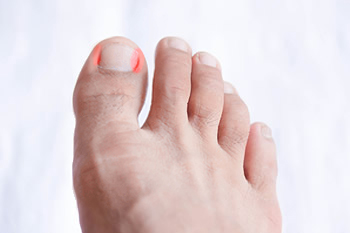Connect With Us
Blog
Items filtered by date: July 2025
Causes and Symptoms of Ingrown Toenails

Ingrown toenails occur when the edge of the toenail grows into the surrounding skin, causing pain, redness, and swelling. Common causes include improper nail trimming, wearing tight or narrow shoes, injury, or genetic factors that affect nail shape. Symptoms often begin with tenderness and swelling along the nail’s edge, progressing to increased pain, warmth, and sometimes infection with pus or drainage. The affected area may feel sore and make walking or wearing shoes uncomfortable. A podiatrist can diagnose an ingrown toenail by examining the toe and assessing the severity. Treatment varies from conservative care, such as soaking, proper nail trimming, and antibiotic ointments, to minor surgical procedures like partial nail avulsion. This procedure removes the problematic portion of the nail, relieving pain and preventing recurrence. If you are have a painful ingrown toenail, it is suggested that you schedule an appointment with a podiatrist for an evaluation and appropriate treatment.
Ingrown toenails may initially present themselves as a minor discomfort, but they may progress into an infection in the skin without proper treatment. For more information about ingrown toenails, contact Dr. Nicholas Przystawski of Central Florida Foot Care, PA. Our doctor can provide the care you need to keep you pain-free and on your feet.
Ingrown Toenails
Ingrown toenails are caused when the corner or side of a toenail grows into the soft flesh surrounding it. They often result in redness, swelling, pain, and in some cases, infection. This condition typically affects the big toe and may recur if it is not treated properly.
Causes
- Improper toenail trimming
- Genetics
- Improper shoe fitting
- Injury from pedicures or nail picking
- Abnormal gait
- Poor hygiene
You are more likely to develop an ingrown toenail if you are obese, have diabetes, arthritis, or have any fungal infection in your nails. Additionally, people who have foot or toe deformities are at a higher risk of developing an ingrown toenail.
Symptoms
Some symptoms of ingrown toenails are redness, swelling, and pain. In rare cases, there may be a yellowish drainage coming from the nail.
Treatment
Ignoring an ingrown toenail can have serious complications. Infections of the nail border can progress to a deeper soft-tissue infection, which can then turn into a bone infection. You should always speak with your podiatrist if you suspect you have an ingrown toenail, especially if you have diabetes or poor circulation.
If you have any questions, please feel free to contact our office located in Leesburg, FL . We offer the newest diagnostic and treatment technologies for all your foot care needs.
